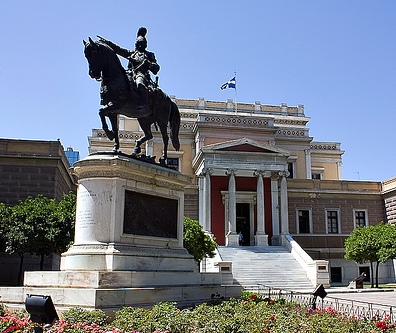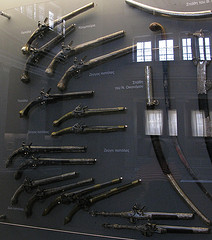

Location: Stadlou 13, Syntagma, Athens
Tel. 210 323 7617
Subway: Syntagma
Tram train: 1, 2, 4, 5, 9, 10, 11, 18
Open: 9am- 2pm Tue- Sun
Closed: public holidays


The National Historical Museum was founded in 1882 by the
Historical and Ethnological Society of Greece (IEEE). Its
subject is the history of modern Hellenism, from the Conquest of
Constantinople to World War II and the promotion of the
political, social and spiritual evolution of Hellenism from the
period of the Turkish occupation to the present day.
The
National Historical Museum also functions as a research center
for modern Greek history. Since 1960, the Museum has been
permanently housed in the Palace of the Old Parliament on
Stadiou Street (Kolokotroni Square). The Historical Document
Archive, the library and the photographic archive of the
Historical and Ethnological Society of Greece are housed in the
same building.
Since 1979, the Mansion of Lazaros
Kountouriotis in Hydra has been owned by the Historical and
Ethnological Society. Since 2001, a branch of the National
Historical Museum has been organized and operates there.
The Historical and Ethnological Society of Greece was founded in
1882, at a time when the Greek state was experiencing economic and
social development. Its founding members were important representatives
of the sciences, letters and arts of the period such as the journalist,
scholar and later mayor of Athens, Timoleon Filimon, the folklorist
Nikolaos Politis, the historian Spyridon Lambros, the historian
Dimitrios Kambouroglou, the playwright Timoleon Ampelas, the publisher
of Children's Fitness, Nikolaos Papadopoulos, the journalist Babis
Anninos, the historian and geographer Antonios Miliarakis, the poet
Georgios Drosinis, the university scholar and scholar Alexandros Rizos
Ragavis and others.
The principles of the Society were identified
with the national ideology of the time which sought the identity of
modern Hellenism and sought to make clear the continuity of the Greek
nation from antiquity to modern times.
The objectives of the
Society were defined as the collection, preservation and display of
relics and testimonies that reveal aspects of the history of modern
Hellenism. To achieve this goal, the IEEE quickly proceeded to the
creation of a museum, historical archive and library, while from 1883
the publication of a scientific periodical called Bulletin of the
Historical and Ethnological Society of Greece began, which contained
studies of historical and folkloric content.
Today, the IEEE has
developed a rich publishing activity with the ultimate goal of
publishing most of the relics and historical documents kept in the
Museum's collections, the Library, the Archive of Historical Documents
and its Photographic Archive. He also takes care of the periodical
edition of the scientific journal Tekmeria Historia.
The Museum was created in 1882, with the aim of preserving and
displaying the evidence that began to be collected by the Historical and
Ethnological Society. For many years it was housed in the main building
of the National Technical University of Athens, following a request by
the IEEE to the then Prime Minister of Greece, Charilaos Trikoupis. In
1960 the collection was moved to its current roof, in the Old Parliament
building on Stadiou Street.
The opening and operation of the
Museum is connected with the first official presence of the Society, on
March 25, 1884, when, with the cooperation of the "Parnassos"
Philological Association, it organized the "Exhibition of Monuments of
the Sacred Struggle" in a hall of the National Technical University of
Athens, with the supervision of the historian Konstantinos
Paparrigopoulos. After it ended, most of the exhibitors deposited the
heirlooms they had offered to be exhibited, to the Society. These relics
formed the core of the first permanent exhibition of the Historical
Museum, which, from 1884 and for a number of years, was housed in the
main building of the Metsov Polytechnic.
The enrichment of the
Museum's collections continued unabated over the years through donations
and selective purchases. The collection of relics was not only limited
to the limits of the limited area, until the Balkan Wars, of the Greek
state, but also extended to other areas where there were Greeks, such as
Asia Minor, Epirus, Macedonia, the islands of the Eastern Aegean and
Cyprus.
In 1932, given the transfer of the Parliament and the
body of the Senate to the building of the Old Palaces, Eleftherios
Venizelos proceeded to grant the building of the Old Parliament to the
IEEE for the permanent installation of its Museum. This concession was
repeated in 1935 by the Tsaldari government, after the transfer of the
Parliament to the Old Palace building. From 1938, actions were taken and
in March 1940, the process was initiated for the definitive installation
of the Museum in the building of the Old Parliament, but the entry of
Greece into the Second World War intervened, so the relics of the
National Historical Museum were removed and kept in the area of the
Archaeological Museum.
After the Liberation, a building was
leased at Amalias Avenue 38, where the relics were temporarily
exhibited. In 1960 the building of the Old Parliament was finally handed
over to house the Museum. After two years of restoration work on the
building, the National History Museum held its grand opening in its new
location on June 21, 1962.
The Museum is constantly being
enriched, while at the same time taking care of the preservation and
good preservation of the heirlooms. It organizes periodical exhibitions
and publishes publications with the aim of documenting historical memory
and contributing to national self-awareness.
The museum's exhibition covers the period from the last years before
the Fall of Constantinople to the Greco-Italian War of 1940-41. It is
developed in a perimeter route of the meeting room of the Old Parliament
of the elevated ground floor of the building. Today, the hall is only
open for official award ceremonies (eg Onassis Foundation awards, etc.)
as well as club meetings. The exhibits are presented in 13 rooms and 6
specially designed corridors, following chronological order, and
focusing mainly on the war adventures of the country during this
historical period, with the exhibits starting on the left of the main
entrance and ending on the right.
It begins with exhibits
concerning the last years of the Byzantine Empire, the Greek scholars of
the diaspora, illustrated manuscripts, the statue of the last emperor of
Byzantium and the following Venetian and Ottoman rule in the present
Greek area, such as helmets, armor, weapons and coins. The room dealing
with the pre-revolutionary spaces hosts the Map of Greece by Rigas
Feraios, the office of Adamantios Korais as well as relics, symbols and
flags of the Friendly Society.
The largest part of the
exhibition, which occupies three rooms and the same number of corridors,
concerns the Greek Revolution of 1821. It hosts portraits of the
Fighters of 1821, various exhibits covering all aspects and periods of
the Revolution, such as the naval struggle, Philhellenism, the
contribution of the lot, the exit of Messolonghi, etc. Many personal
items, weapons and war equipment of fighters of the Revolution are on
display.
The period of the foundation of the modern Greek state
is represented through the collection of personal items of personalities
such as Ioannis Kapodistrias and the first kings of Greece, Othona and
Amalia (1833-1862). Also on display are the original Constitution of
1843 and relics, flags from the revolutions in Epirus and Thessaly.
There are also exhibits from the Cretan revolutions of the 19th century,
including the flag of the Arkadiou monastery, but also from the period
of the Macedonian Struggle. Personal belongings of King George I
(1864-1913) and several prime ministers of the same era are also on
display.
The permanent exhibition also features flags from Greek
and Turkish divisions (spoils) from the Balkan Wars and the Asia Minor
Campaign, the loader of the battleship Averof damaged by the Battle of
Hellas as well as oil paintings from the Greco-Italian War of 1940 -
1941 that complete the war part of the exhibition. In the same room, the
high priestly miter of Chrysostom of Smyrna and the condylophorus with
which Eleftherios Venizelos signed the Treaty of Sevres in 1920 are
still housed.
The exhibition concludes with national and local
costumes from various parts of Greece and from regions where there was
historically a Greek presence, embroideries, jewelry and ceramics, as
well as furniture of historical figures of the 19th century. In most
rooms there are also paintings by Greek and foreign painters that depict
several of the important figures of each period.
The Library of the Historical and Ethnological Society of Greece was
created in 1884 under the supervision of Antonis Miliarakis. The
purposes of its creation were research, documentary and educational. In
fact, for its development, the IEEE proceeded both in 1891 and 1895 in
the purchase of Greek and foreign language books related to the Greek
Revolution.
Since then it has continuously continued its course
and at the same time it is constantly enriched with new acquisitions.
Over the years, sections have been formed that have as their object the
History of Hellenism from the 15th to the 20th century, which are
distinguished for their completeness in terms of the topics they cover
(History of the Byzantine Empire, Frankish rule, Turkish rule, Greek
History 19th and 20th centuries, including the Greek Revolution of 1821,
the Kapodistrian period, the British rule in the Ionian Islands, the
Crimean War, the Greek revolutions of the 19th century, the Macedonian
Struggle, the Balkan Wars, the Asia Minor Disaster, etc.).
The
main mission of the library is the collection and storage of the forms
(books, magazines, etc.) that complement the existing thematic sections
and the processing at the level of librarianship. The purpose of the
library is primarily bibliographic research and study by the museum's
scientific staff for the documentation of its collections and the
historical relics that make them up, as well as the service of
researchers.
Archive of Historical Documents
The archive of
historical documents consists of approximately 350 archival units that
include documents from the pre-revolutionary years up to the period of
the National Resistance, handwritten codices from the 11th to the 20th
century as well as various forms such as proclamations, decrees,
enactments, etc. Historically, first authority Georgios P. Kremos took
over the management of the archive, while his successors included
Antonios Miliarakis, Spyridon Lambros, Aristotelis Kourtidis and others.
Photographic file
The photo archive has a huge collection
consisting of about 100,000 photos of various sizes. Most are original
and some are painted. It also has approximately another 10,000
photographs contained in 142 photo albums as well as several thousand
postcards.
Maintenance workshop
The museum's conservation
laboratory was created in 1993 and in 2006 it was moved to new renovated
rooms. It has a conservation department for paper objects, books and
photographs, a conservation department for paintings and a conservation
department for metalwork and ceramics.